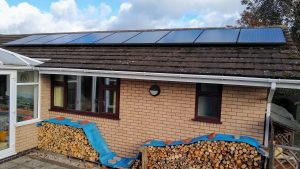
What if I don’t have a south-facing roof? Don’t let that put you off investigating. It’s not a matter of all-or-nothing. Ours are south-east and south-west facing, and a too-shallow angle, but they have still been well worthwhile. The Energy Saving Trust has a calculator, to work out what benefit your particular installation will give you. You can experiment with what it would be *if* it were south facing, and compare to the actual direction. For East and West facing, you may want some on both sides. But don’t get hung up on facing South.
How many panels do I need? No doubt a salesman will be happy to advise for your specific circumstances, but we generally think as many as you can fit, in line with what you can afford. There’s a limit on what inverters can send to the grid, without special permissions, so 4-5kW is a reasonable maximum. Whatever electricity you generate but can’t use directly, will be sent off to the National Grid and contribute to the renewable energy available to everyone.
How long will they last? Our guarantee is for 25 years, but OF COURSE we won’t replace them then, they will just gradually get a little bit less efficient over time even while they continue to work. 35+ years at least, of worthwhile generation. (We did need to replace the inverter a couple years ago, which was as expected.)
Are they a lot of work to maintain? No, there is nothing at all to do, in our experience. We’ve rinsed them with a hose a couple times, it didn’t make any noticeable difference, so haven’t bothered since. We’ve never had to protect them from birds either – none of our friends have needed to do bird-proofing either, though your situation may differ.
I don’t want holes drilled in my roof! Don’t worry, that’s NOT how they are installed. If you are concerned, this page explains the process. Though it’s important to avoid cowboy installers!
What happens to old solar panels? In the UK, we have a facility in Scunthorpe which dismantles old panels and recycles the materials within. Read about how they do this.
What makes solar panels NOT worthwhile? Probably the biggest negative to consider is if your roof is heavily shaded by trees or buildings most of the time, then you will lose perhaps a third of your potential generation. That makes even more difference than facing north. The Energy Saving Trust calculator will be really useful for you to work out relative generation, though the calculator is a bit old. (You can reduce the impact of trees somewhat by individual panel inverters, but you probably don’t want to bother with them otherwise, they add more cost than benefit.)
Do I need a battery? No, you don’t need one. You can choose to time washing the clothes for when the sun is shining, or replace your kettle with a <1kW travel kettle which enables it to need less from the Grid during the day. And whatever you can’t use, the Grid will receive, which benefits the national energy mix. Our panels paid for themselves years ago, but we’re still really glad we got a battery.
How do I get the most from my solar panels? Everything you generate but don’t use is exported to the Grid, which contributes to the renewable generation for everyone and is a good thing. But what if you want them to earn their keep on your roof?
- Have a diverter to your immersion heater. They are a relatively inexpensive gadget that takes any surplus solar power and sends it to heat the water. If you don’t have a hot water tank, you may want to consider having one installed. We have free hot water from (roughly) mid February to mid October. AND we therefore use less gas, also.
- Change the way you do things. Running the washing machine or dishwasher during the day, for example, or having a smaller kettle. This requires some creative thinking!
- Get a battery. A battery will allow you to store power you generate during the day, and use it overnight instead. We had an 8kWh battery installed in July, and in the very gloomy August of 2021 our usage from the Grid was 4.1% compared to the previous year; September was 3.3% and October about 12.5%; and November was 50% compared to last year. (From December we’re charging the battery overnight at an off-peak rate, and using the stored energy during the day.)
This information is based on our personal experience and energy bills, and information from the Internet and other friends who also have panels. As they say, “Your Mileage May Vary” and it’s worth doing your own calculations for your situation. Our panels are not optimally angled, but still we have been producing 10% more than the EST calculator has predicted. And the cost of energy will continue to rise.
Isn’t it time that new-build houses, as well as being *properly* insulated, were built ‘solar ready’ – with roofs facing south, and at the optimal angle? Even if not actually installed?